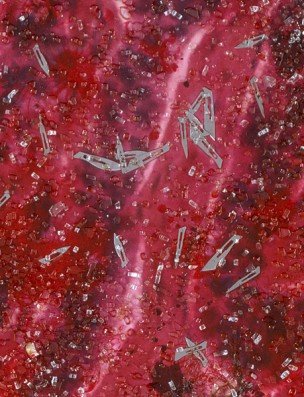Damien Hirst
dal 1/6/2007 al 6/7/2007
Segnalato da
1/6/2007
Damien Hirst
White Cube, London
Beyond Belief. In this exhibition, the artist continues to explore the fundamental themes of human existence - life, death, truth, love, immortality and art itself. In two new series of paintings - the Fact Paintings and the Biopsy Paintings - Hirst confronts, as he puts it, 'the intense joy and deep-set anxiety we can all feel in hospitals, where we are surrounded by both creation and decay'.

Beyond Belief
White Cube is pleased to announce a major solo exhibition of new work by Damien
Hirst. Beyond Belief takes place at both White Cube Hoxton Square and White Cube
Mason's Yard and is the most significant and ambitious exhibition of new work by the
artist to date.
In this exhibition, Hirst continues to explore the fundamental themes of human
existence - life, death, truth, love, immortality and art itself. In two new series
of paintings - the Fact Paintings and the Biopsy Paintings - Hirst confronts, as he
puts it, 'the intense joy and deep-set anxiety we can all feel in hospitals, where
we are surrounded by both creation and decay'. The Fact Paintings depict the birth
of the artist's youngest son Cyrus by Caesarean section in August 2005 and are
brutal, yet tender, representations of the horror and beauty of child-birth.
The Biopsy Paintings, on the other hand, are based on biopsy images from the Science
Photographic Library of thirty different forms of cancer and other terminal
illnesses. In this series Hirst uses broken glass, scalpel blades and blood-like
pools of paint in sumptuous, abstract swathes that both repel and attract in equal
measure. 'I've always thought that art is a map of a person's life, so it naturally
changes as you change and get older', Hirst said recently. 'I suppose since I've
become a father, I think even more about the end'.
There are twelve new sculptures, including seven major formaldehyde works from the
ongoing Natural History series. Death Explained, originally conceived as a drawing
in 1991, presents a tiger shark divided longitudinally with each half of its body
suspended in a separate tank of formaldehyde. The shark, which Hirst once summed up
as 'a thing to describe a feeling', has been dissected in order to allow the viewer
to pass through it and perhaps to understand it more fully. But in the end, as Hirst
has observed of death, 'You are left with no answers, only questions'.
Several works address the complex relations between art, science and religion.
Arguably more than any artist of his generation, Hirst is preoccupied by the Western
tradition of Christian iconography. Saint Sebastian - Exquisite Pain savagely
decants the Saint's martyrdom into a single tank containing a black calf, its body
pierced by dozens of arrows and cable-tied to a steel post. In God Alone Knows, a
triptych featuring three flayed and crucified sheep in three tanks, Hirst
re-presents for today the visceral brutality of Christ's death, yet there is an
unexpectedly quiet beauty as the forlorn and tragic figures appear to float against
their mirrored grounds, as if resurrected. In The Adoration, Hirst reconstructs the
final phase of the Nativity. A steel and glass vitrine is divided, one half of which
is then sub-divided into three equal spaces that each contain a sheep, kneeling in
supplication to a cast sterling-silver skeleton of a human foetus, housed in an
incubation unit. Here, Hirst throws into sharp focus conflicting notions of belief,
devotion and conformity.
The exhibition's dramatic culmination, For the Love of God, is a life-size cast of a
human skull in platinum, covered entirely by 8,601 VVS to flawless pavé-set
diamonds, weighing a total of 1,106.18 carats. It is without precedent in the
history of art. On one level, the work is a traditional 'Memento Mori', which
examines the transience of human existence. 'The skull is out of this world,
celestial almost' writes the distinguished art historian Rudi Fuchs. 'It proclaims
victory over decay. At the same time', Fuchs continues, 'it represents death as
something infinitely more relentless. Compared to the tearful sadness of a vanitas
scene, the diamond skull is glory itself'.
Damien Hirst was born in 1965 in Bristol, UK. He lives and works in London and
Devon. For the past two decades he has been widely acknowledged as the most
important and influential artist of his generation.
A fully illustrated catalogue with texts by Will Self and Hans Ulrich Obrist will
accompany the exhibition. In addition, a book entitled 'For the Love of God: the
Making of the Diamond Skull' with an essay by Rudi Fuchs will be published.
White Cube
48 Hoxton Square - London
Open Tuesday to Saturday, 10am to 6pm but will also be open on Sunday 3 and Monday 4 June.
Free admission



